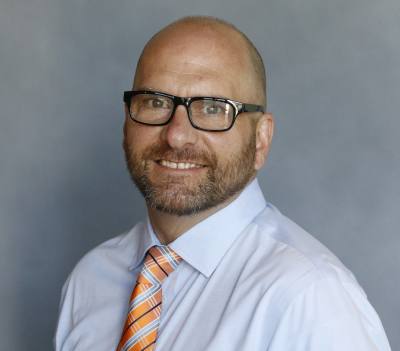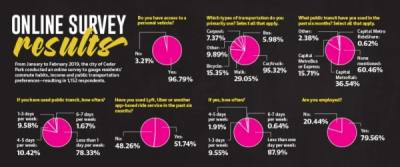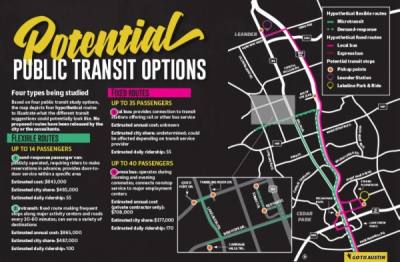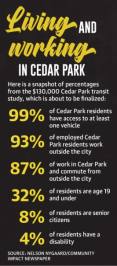Twenty-two years—and more than 50,000 residents—later, Cedar Park is considering rekindling that relationship or starting a partnership with a private transit company, according to officials. Within the next few weeks, the consulting firm is expected to release a final version of a transit study that will recommend options, costs and the viability of different public transportation options within the city.
The purpose of the transit study—which cost the city $130,000 and is being written by consulting firm Nelson Nygaard—is to “identify available transit options and to evaluate options based on cost efficiency and effectiveness,” according to city spokesperson Jennie Huerta.
According to officials and the transit study’s latest draft, those options range in scope from passenger vans making door-to-door stops for commuters to large buses transporting city residents between park-and-ride locations and major employment centers outside the city.
With Cedar Park’s steady development and planned high-density, mixed-use projects planned for the near future, City Council asked staff to “take a fresh look” at available transit options, Huerta said.
Public transit history
After terminating its bus service contract with Capital Metro in 1998, the city continued to research and slowly expand public transit options, according to a transit presentation at the Nov. 14 Cedar Park City Council meeting.The city participated in transit studies with the Capital Area Rural Transportation System in 2002 and Capital Metro in 2008, when the city’s population reached 50,000, according to James Gamez, a spokesperson for Nelson Nygaard.
The 2008 study resulted in a single local bus route between Lakeline Station, a Capital Metro rail stop in Northwest Austin, and Lago Vista, a smaller community west of Cedar Park on the Colorado River, according to Gamez. In 2010, the city rejected a proposal by Capital Metro for additional bus service within the city.
In 2011, Capital Metro began bus service that cut across Cedar Park, from Lakeline Station west to the Austin Community College Cypress Creek campus in Cedar Park. Approximately 40 people use that service—Route 214—each weekday, according to Gamez.“A lot of people use [the campus route], primarily coming from Austin to the ACC campus,” Gamez said at the Nov. 14 council meeting.
In addition to the Lakeline-Lago Vista and Lakeline-ACC Cypress Creek routes, other public transportation options exist within the city. According to the report, each weekday:
More than 900 people take either MetroRail or MetroExpress, Austin-area public rail and bus service, from Lakeline Station to Austin;
80 city residents ride in 11 Capital Metro vanpool groups to South Austin; and
through Drive-A-Senior Northwest, a nonprofit that receives $20,000 annually from the city, five to 10 Cedar Park senior citizens are transported daily.
Transit study
In June 2018, the city approved a contract with Nelson Nygaard to craft the study, which was paid for through the city’s general fund, according to Huerta. To craft the transit study, Gamez said Nelson Nygaard analyzed traffic data, conducted an online poll with the city—which drew 1,152 responses—and culled data from the U.S. Census Bureau.Initially, Nelson Nygaard studied the feasibility of seven different transit options, according to earlier drafts of the transit study. They ranged in scope from the city partnering with private ride-sharing companies to exploring commuter rail service. Capital Metro’s MetroRail Red Line travels through the city to reach its final stop in Leander. Both ride-sharing partnerships and commuter rail were ruled out due to cost concerns, according to Gamez.
The latest draft concludes that there are four “potential opportunities” for public transit in the city: two that involve researching a pilot program for hyperlocal van transport in the city and two that involve communicating with Capital Metro about possible contracting options for bus service.Gamez said that 93% of Cedar Park residents who are employed work outside the city limits—and 87% of those who work in Cedar Park commute from outside the city, according to the study.
With ongoing residential and commercial development—especially the planned high-density Indigo Ridge and Bell District developments—traffic on the area’s roads is sure to increase, according to Gamez.
“That will mean more people living in a tighter space,” he said.
After the Nov. 14 presentation, Council Member Anne Duffy credited the consulting firm and city staff for the level of response received from residents and stakeholders.
“The community outreach was outstanding on this,” she said.
After the Nov. 14 presentation Mayor Corbin Van Arsdale said he felt more comfortable with the fact that the city funded the study. The 2008 study was funded by Capital Metro, creating a perception of bias by the Austin-area public transit service, he said.After the Nov. 14 presentation, a Nelson Nygaard representative predicted the final version of the transit report would be ready in “four to six weeks,” or by Dec. 26.
City officials expect the final version report soon, Huerta said.
Marisa Charpentier contributed to this story.








